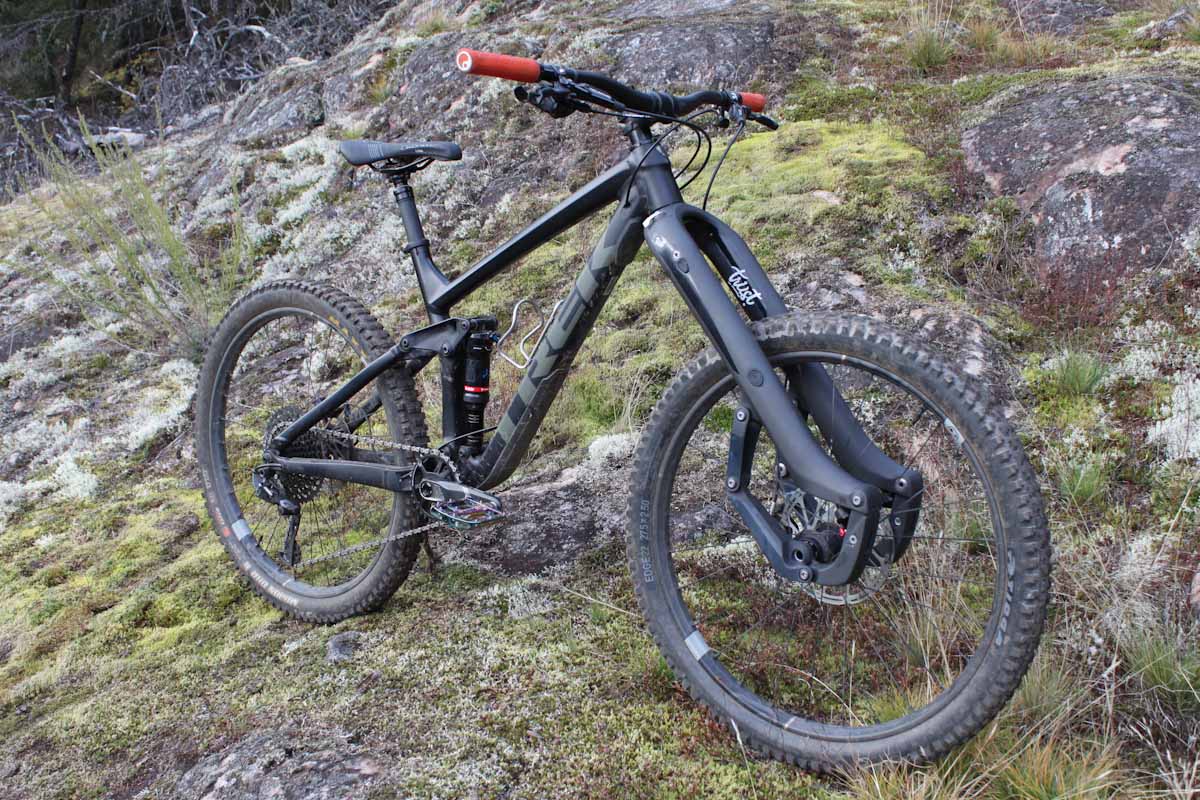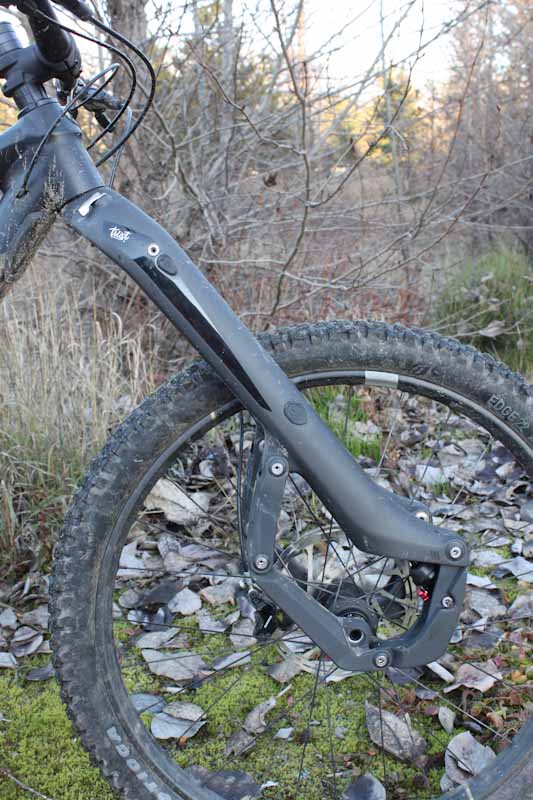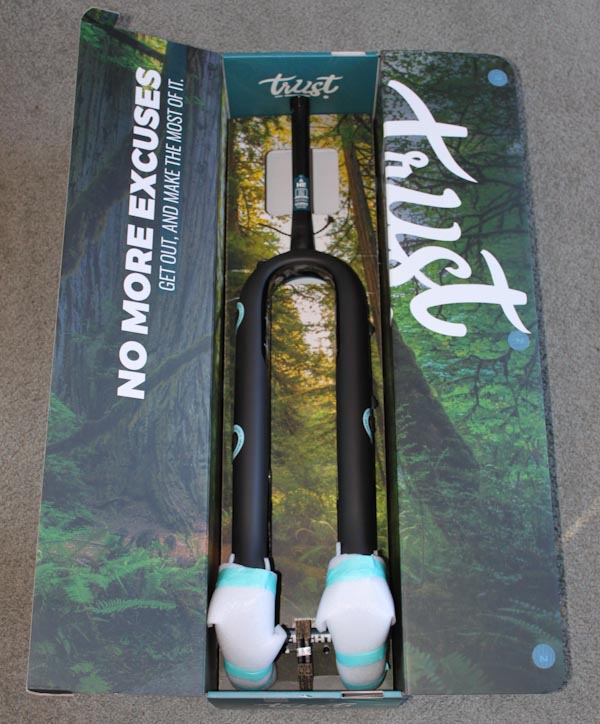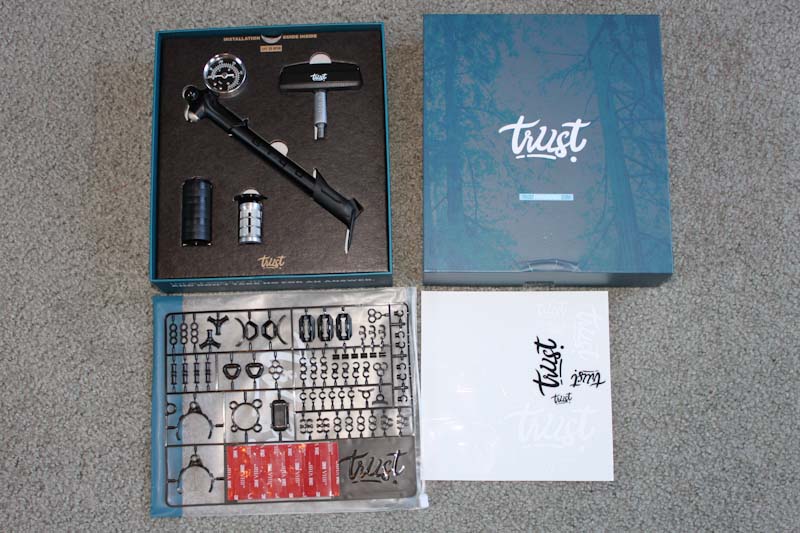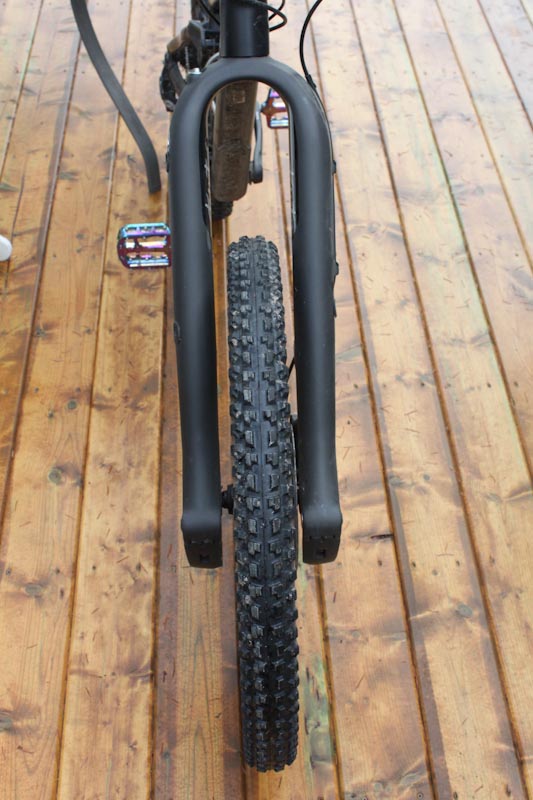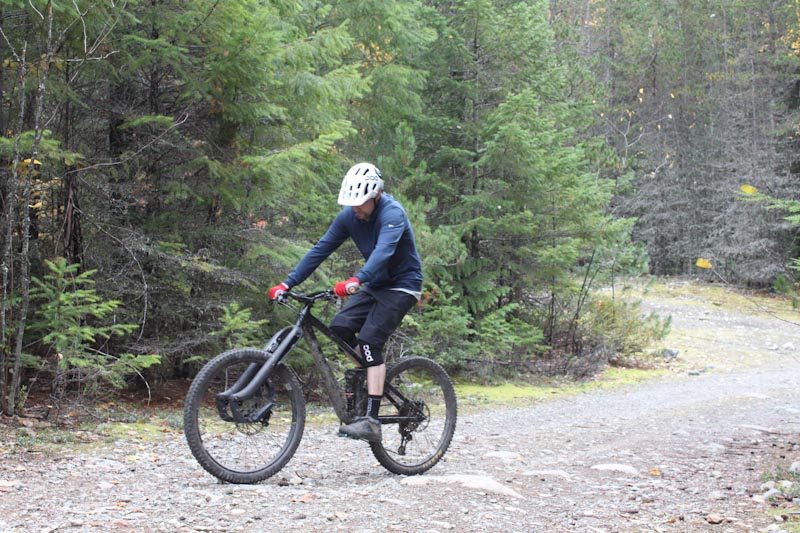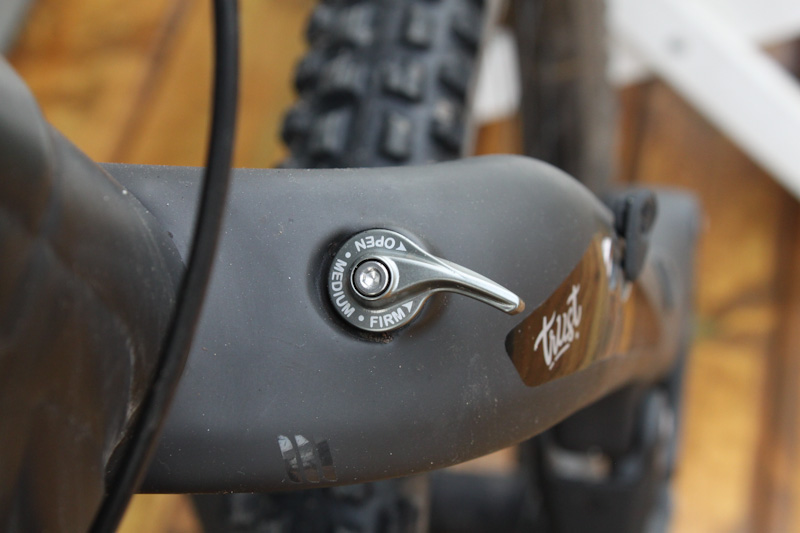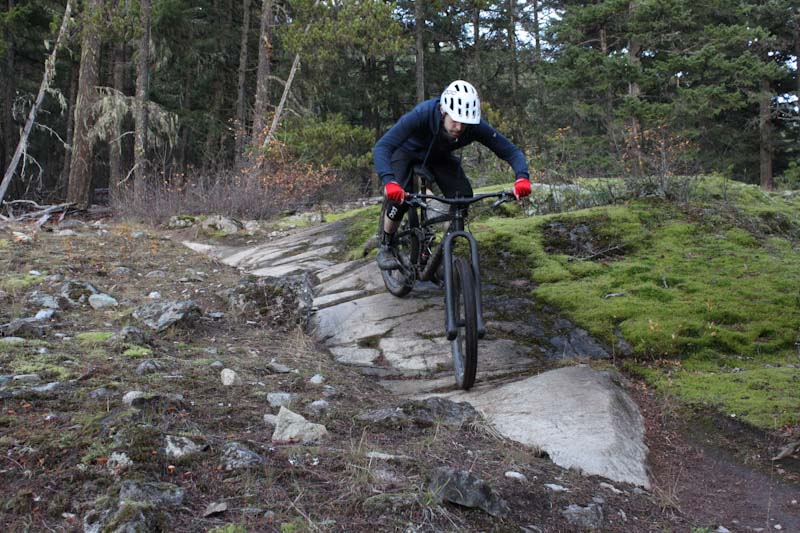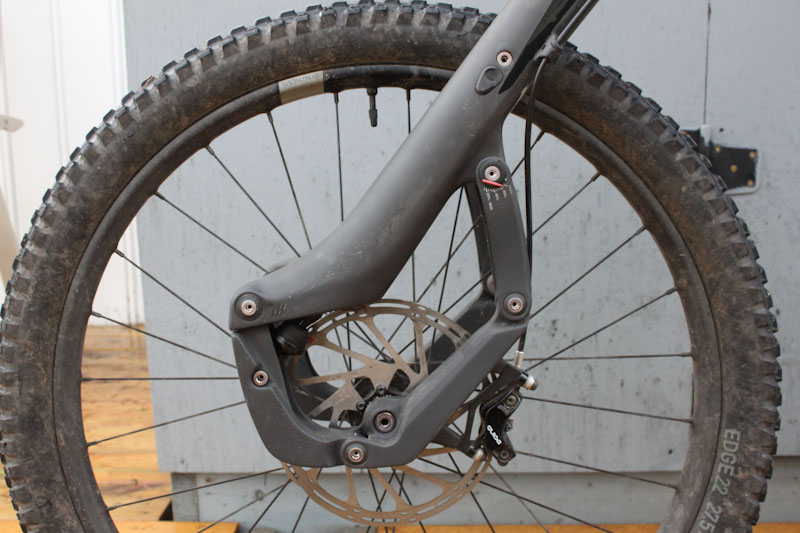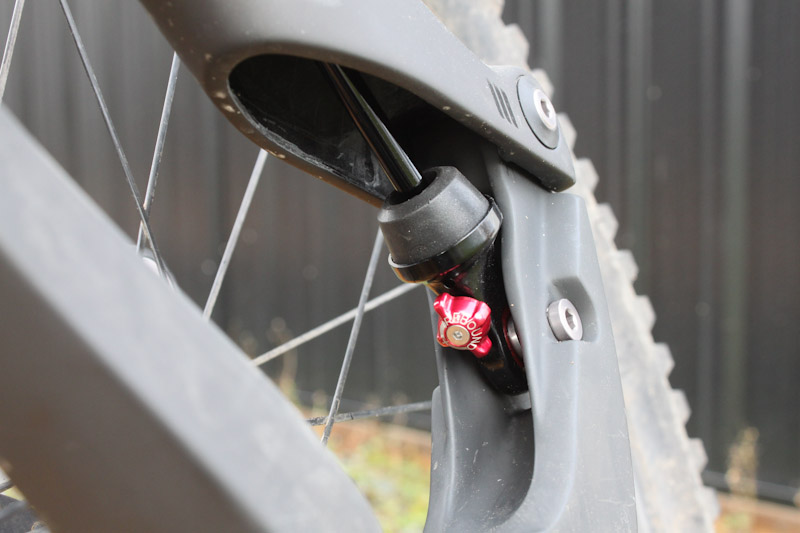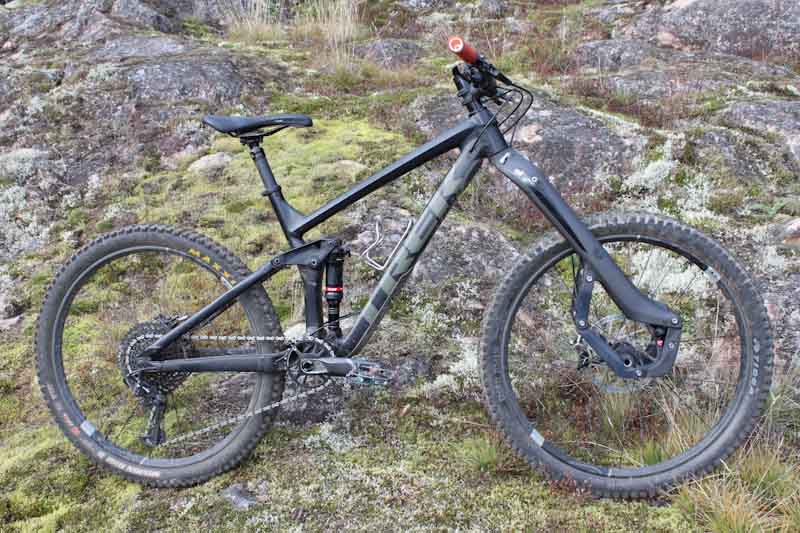For many years bike brands have been honing the way our rear wheels take an impact – so doesn’t it make sense to do the same thing with the front wheel? The folks behind Trust Performance (including suspension wiz Dave Weagle) debuted their ‘trailing multi-link’ concept with the Message fork in 2018, and they’ve recently released a longer travel, enduro-focused version called the Shout. After a few weeks of riding the Shout on my home trails, I’d say linkage forks could be here to stay.
A few months ago I got a very brief chance to try the Shout in the Whistler Bike Park, and my one-ride review states that I wasn’t too ‘wowed’ by its performance. In hindsight, I think the wild appearance of the Shout left me with grand expectations that it would feel radically different than a telescoping fork.
However, after riding the Shout on my trail bike for a longer period I noticed where the differences lie, and I’ve changed my mind – I’d now say there are clear advantages to the linkage design, and no major disadvantages to speak of. The Shout proved to provide excellent traction in all situations, and it undeniably handles certain kinds of impacts better than a traditional fork.
Trust Shout Setup:
The Shout is not a cheap fork, and Trust’s fancy packaging reminds you that you’re dealing with high-quality stuff. Inside the big box is a smaller one full of included accessories; You get a shock pump with an extended head (mandatory for this fork), a ‘Torqkey’ torque wrench, eight extra Huck Pucks (volume spacers), a sheet of pop-off cable clamps and accessories, and some clear protective stickers.
Looking at the owner’s guide, setup guide, and accessories I felt a bit intimidated about setting up this fork! I was worried I’d have to absorb a ton of info before I could get out and enjoy this thing. There are 27 pages of info in the owner’s guide, but the 12 page setup guide is pretty simple.
There are some interesting things found in the owner’s guide. According to the fine print “…failure to use a 10mm spacer above the stem and failure to retain 7-8mm of steerer tube above the stem may lead to fork failure, serious injury and/or death,” (editor’s note: making sure the steerer extends above the stem and the use of a spacer above is a fairly common requirement for forks with carbon steerers). There’s more important stuff in there too, so RTFM!
After reading the guides, installing and setting up the fork was quite easy. Having to pump up the air springs in each leg to equal pressures is the biggest difference between setting up the Shout and a traditional fork (and kudos to Trust for using air springs that run your body weight in psi). The Shout does use an expanding compression nut that doesn’t have a star washer due to the carbon steerer, but it’s simple to install.
Like most current forks, the Shout’s bottom-out resistance can be tuned by adding or removing Huck Pucks. The fork comes with three Huck Pucks installed, and conveniently that seemed to be OK for me. Trust made sure adding or removing Huck Pucks was a simple process, so most riders should be able to do it with just a few tools. In lieu of an O-ring, the Shout has a travel indicator dial on the left leg so you can easily see how much compression you’re getting from the fork.
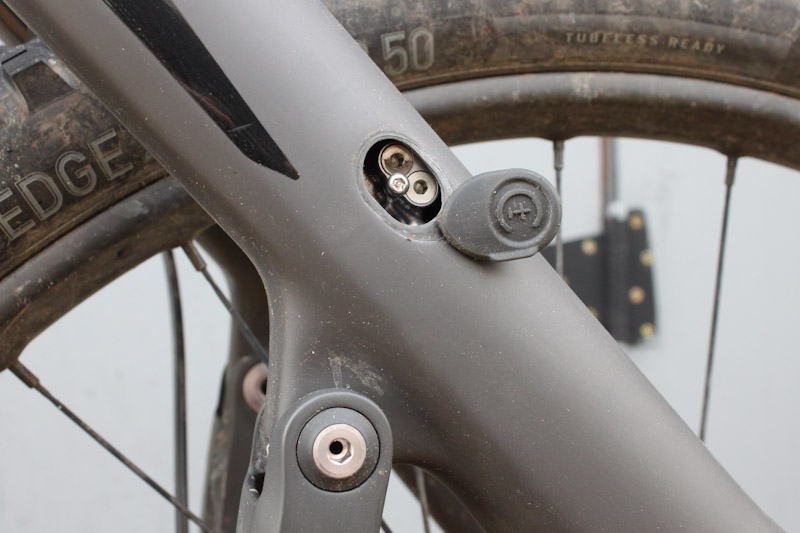 Aside from rebound, the Shout does require tools for simple adjustments. The air springs each have caps threaded on (which I was told should be left on at all times), so any air adjustments require a 4mm allen key. A 3mm key is used to adjust the Open or Medium mode compression, and you can feel the bolts clicking through each increment as you twist them.
Aside from rebound, the Shout does require tools for simple adjustments. The air springs each have caps threaded on (which I was told should be left on at all times), so any air adjustments require a 4mm allen key. A 3mm key is used to adjust the Open or Medium mode compression, and you can feel the bolts clicking through each increment as you twist them.
Fitment:
The Shout’s 178mm of ‘contour travel’ can replace 160-180mm forks on 29ers, 27.5+ or 27.5” bikes. The Shout has adequate clearance for 29×2.6” or 27.5×2.8” tires, its brake post-mount accepts 180mm rotors, and the 15x110mm Boost axle tightens with a 6mm allen key.
The 160mm Lyric I took off my 27.5” Trek Remedy has a 552mm axle-to-crown length, and the Shout is longer at 580mm. Since the Shout’s offset is dynamic (it’s longer at the beginning of the stroke, but gets shorter at mid-stroke) it’s tough to compare it to my fork. Despite these differences, the Shout didn’t feel like it changed my steering angle, wheelbase or stack height by that much. I was pleased how familiar my bike felt after the swap.
A special note for Trek owners – After realising that my frame has a bumper on its down tube instead of having clearance for a fork crown, I asked Trust if I was OK to keep riding the Shout on this bike. Despite its carbon ‘crownless’ construction, they said they had no concerns about the fork contacting the frame bumper.
Ride Impressions:
The first thing riders should know is the Shout behaves much like any traditional fork in terms of travel usage. I wound up running the fork at a few psi under my body weight with a lot of rebound and very little compression added, which is similar to how I set up most forks. After a rough descent in Open mode, I would hit 95-100% travel. Climbing singletrack trails with the Shout wide open I’d get about halfway through.
The Shout offers Open, Medium and Firm modes. One unique thing about the Shout is how the first 20% of its travel is very lightly sprung regardless of which mode you’re in, making for a highly sensitive ride that tracks very smoothly over small bumps. Climbing a gravel road, for example, you can take advantage of the Firm mode’s support but still enjoy a comfortable, smooth ride.
Another advantage of the Shout’s soft initial stroke is that it reduces front end bouncing, especially on steep climbs where your weight shifts backwards. When your front end isn’t heavily weighted, the Shout allows the wheel to hover along and stay planted over small bumps, where traditional forks tend to bounce a bit more. This provides a notable improvement in both traction and ride comfort while climbing. The Shout also has a blow-off valve, so if you hit something harshly in Firm or Medium mode it will open up and absorb the hit.
Firm mode adds a lot of compression, so it’s best suited for roads or very smooth trails. The adjustable Medium mode is much more versatile; I climbed singletrack trails in Medium mode with the compression at Trust’s recommended setting, and it kept the fork limited to just under 30% travel. I then tried the Medium mode’s softest setting, and got a bit more movement out of it. Hitting any bump in Medium mode feels stiffer than Open, but softening the compression seems to give the fork a more linear action when it does give way. Climbing technical trails in Open mode, I used up to 60% travel. This mode makes for a supple ride that softens all impacts small or large, and offers the best traction on really bumpy terrain.
Now let’s talk about descending with the Shout. I tore down a few runs in the Shout’s Medium mode, which Trust suggests for flow or jump trails where you might want to keep your front end from feeling too squishy. The fork’s initial softness and blow-off valve allow for a nice balance between traction, bump absorption and support, but even in its lightest compression setting Medium mode isn’t as soft as Open.
Bombing downhill with the Shout wide open is where this fork really feels different from a telescoping type. You know how your rear wheel can make a sharp hit feel like it’s been rounded off? Well with its contoured axle path, the Shout provides that same feeling up front. This was most noticeable under a few specific kinds of impacts – slow compressions like jump or drop landings were butter smooth, and smashing straight-on into rocks or roots felt considerably softer than any traditional fork. The linkage’s action reduces the impact on your arms, but more importantly keeps the front wheel glued to bumpy terrain very well. On smoother, high-speed trails, the lightly sprung initial stroke allows the front wheel to precisely trace small bumps and maintain excellent grip through berms or rougher corners.
There was a middle ground where I felt like the Shout didn’t feel drastically better than any other fork. Somewhere in the mid-speed, medium sized bump area the Shout’s differences seem to become less detectable. The fork is still at least as good as a telescoping type in these conditions, but you don’t feel the linkage’s advantages in chattery sections as much as you do with bigger hits.
Even when cranked to the fast end, the Shout’s rebound looks shockingly slow when you pump the fork up and down. But don’t let this freak you out, as it seems to speed up when you’re mashing through rough terrain. I will say compressions from landings feel slower than normal, and the fork offers a bit less pop off jumps versus a telescoping fork, but the rebound does its job on bumpy stuff. I got to the point where it was rebounding too fast, and had to dial it back to find the sweet spot.

One thing I didn’t notice much was the effect (or lack thereof) of the Shout’s linkage and axle path on the bike’s steering angle. During compressions, the Shout keeps your head tube angle more consistent than a telescoping fork, which dives and steepens up your steering. I expected this to feel wildly different, but it’s actually easy to forget about. I didn’t find the Shout provided a noticeable boost in stability, but on the upside it doesn’t change the way you handle your bike.
I should also note that while the Shout’s axle path does move rearward, it never really makes your front end feel shorter. Whether plowing straight into a big hit or compressing through corners, the minor shrinkage in wheelbase didn’t once leave me feeling front-heavy.
With its all carbon construction, the Shout is one stiff fork. The beefy legs and wide linkages don’t allow any noticeable flex, which helps you hold a straight line through rock gardens and root beds. I’m not the heaviest rider, but this thing felt really stiff to me so I’m sure it’ll feel solid under riders well north of 145 lbs.
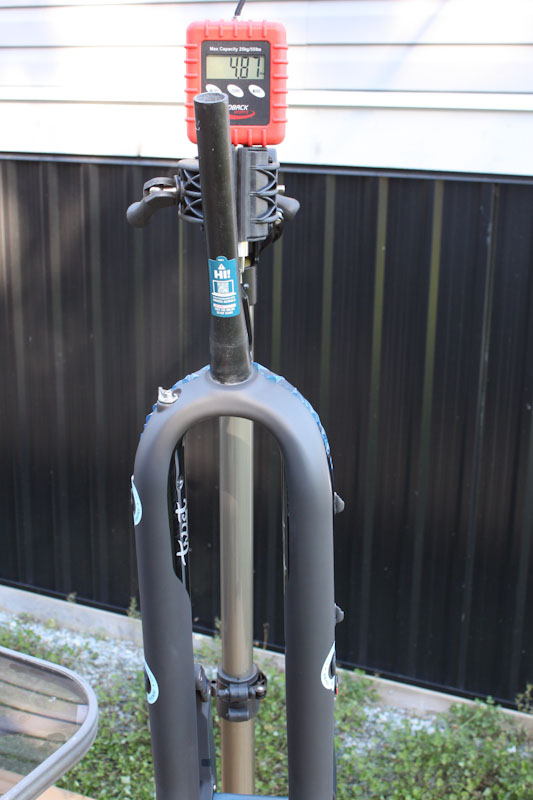
The Shout is not the lightest fork, hitting my scale at 4.87 lbs (Trust claims 2165 g, or 4.77 lbs). By comparison, the Lyric I pulled off my bike weighs 4.53 lbs. On my first few rides I noticed it does make your steering feel heavier than a traditional fork. There is a decent amount of material sitting ahead of your front axle, and it seems to give the Shout some added swing weight. However, after a few more rides I had forgotten about this completely; it’s just a minor adjustment you’ll quickly get used to.
Issues:
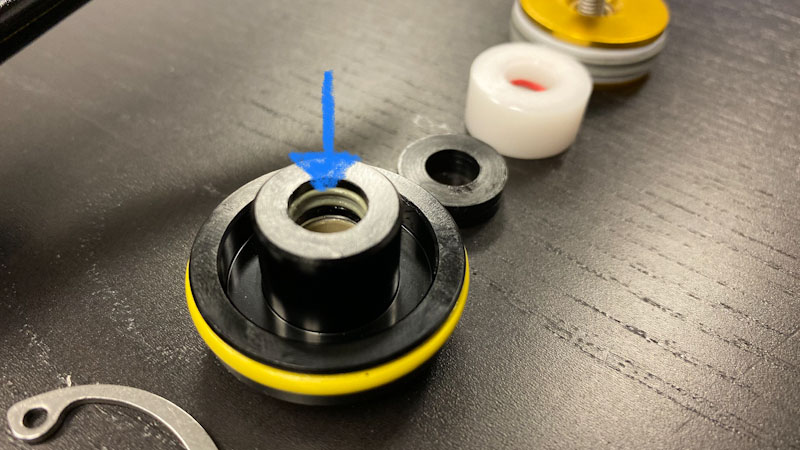
I did encounter one significant mechanical issue with the Shout. After a few rides I determined the air spring in the left leg wasn’t holding air! I’d pump it up to 140 psi, go for a ride, then check it a day later and find about half of the air pressure remaining. I contacted Trust, and they immediately showed concern as the fork I had was one of the first production units. They rushed me out a replacement air spring, and it worked fine.
When Trust inspected the faulty air spring, they quickly found the source of the problem. A seal inside the spring was somehow folded during assembly, and that fold created a tiny gap that allowed the air to leak out. They assured me any Shout buyer facing this situation would receive a replacement spring ASAP, instead of waiting for theirs to be mailed out, serviced and returned.
I had one other issue with my brake line bending into my spokes- I realised I hadn’t installed the provided plugs that hold the brake hose snugly into the fork’s guides (I just had the hose running through the moulded guides) and after I installed them it changed the angle of the cable. Upon deep compressions, the cable bent inwards and rubbed on my spokes. Thankfully a quick adjustment of my caliper’s banjo bolt straightened out the hose, and kept it away from my wheel. This is definitely something to check while you’re setting up the fork.
If riders can get past the odd appearance, Trust very well could be the brand that convinces the MTB industry linkage forks are legit. I came away very impressed with the Shout’s superior ability to absorb and soften impacts, whether from a fast, hard hit on a descent or a rocky patch on a technical climb. The supple initial stroke makes buff trails feel magic-carpet smooth, and the fork’s unique axle path helps your front wheel stay glued to bigger bumps. The worst I can say is that the Shout weighs a tad more than most forks, requires tools for basic adjustments, and looks extremely weird!
The Trust Shout retails for $1975, and is available through Trust dealers or online. The Shout comes in black only, but eight different colored decal kits are available for an extra $15.
